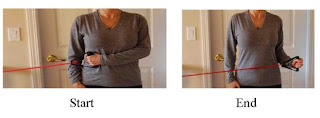Flat Feet and Knee Pain
As a Physical Therapist, you are taught not to have "tunnel vision" when considering a painful body region. It is recommended that you "look" (assess) one joint above and one joint below that painful area. Knee pain can have many causes. Although the pain may be felt at the knee joint, the source of the pain many times is at the foot/ankle joint. As a clinician, assess your client for flat or pronated feet.
The left foot would be considered pronated or "flat" as you can see by the angle drawn
The pronation of the foot creates medial or internal rotation of the tibia/lower leg. To see this, stand up and flatten the arch of your feet. Do you feel the medial/internal rotation of your lower legs?
Upon doing this, your knees will slightly turn in toward each other.
The pronation of the foot creates medial or internal rotation of the tibia/lower leg. To see this, stand up and flatten the arch of your feet. Do you feel the medial/internal rotation of your lower legs?
Upon doing this, your knees will slightly turn in toward each other.
If the pronation is not corrected, then this medial/internal rotation will happen with activity such as jumping. This inefficient movement pattern may be the source of your knee pain.

Many times, this type of knee pain will be felt along the inside/medial aspect and inferior/lower aspect of your knee cap especially upon jumping or stair climbing (descent). One initial treatment for this condition is to purchase an over-the-counter arch support/orthotic to place in your shoe.
This will maintain your arch, and limit the "down and in" medial rotation of your lower leg. Muscle length and strength should also be assessed in order to improve your condition. Finally your movement patterns should be assessed and corrected.










